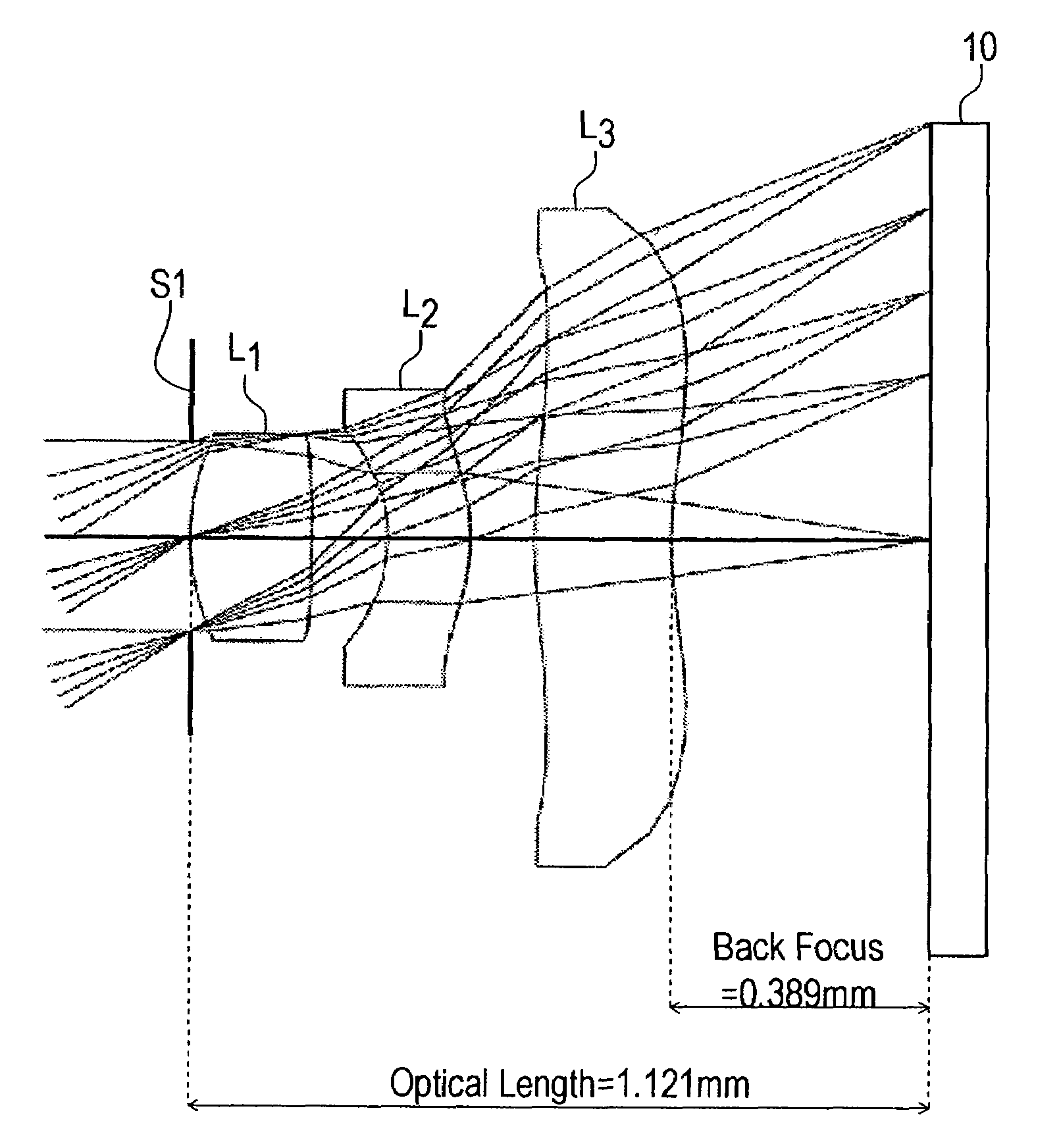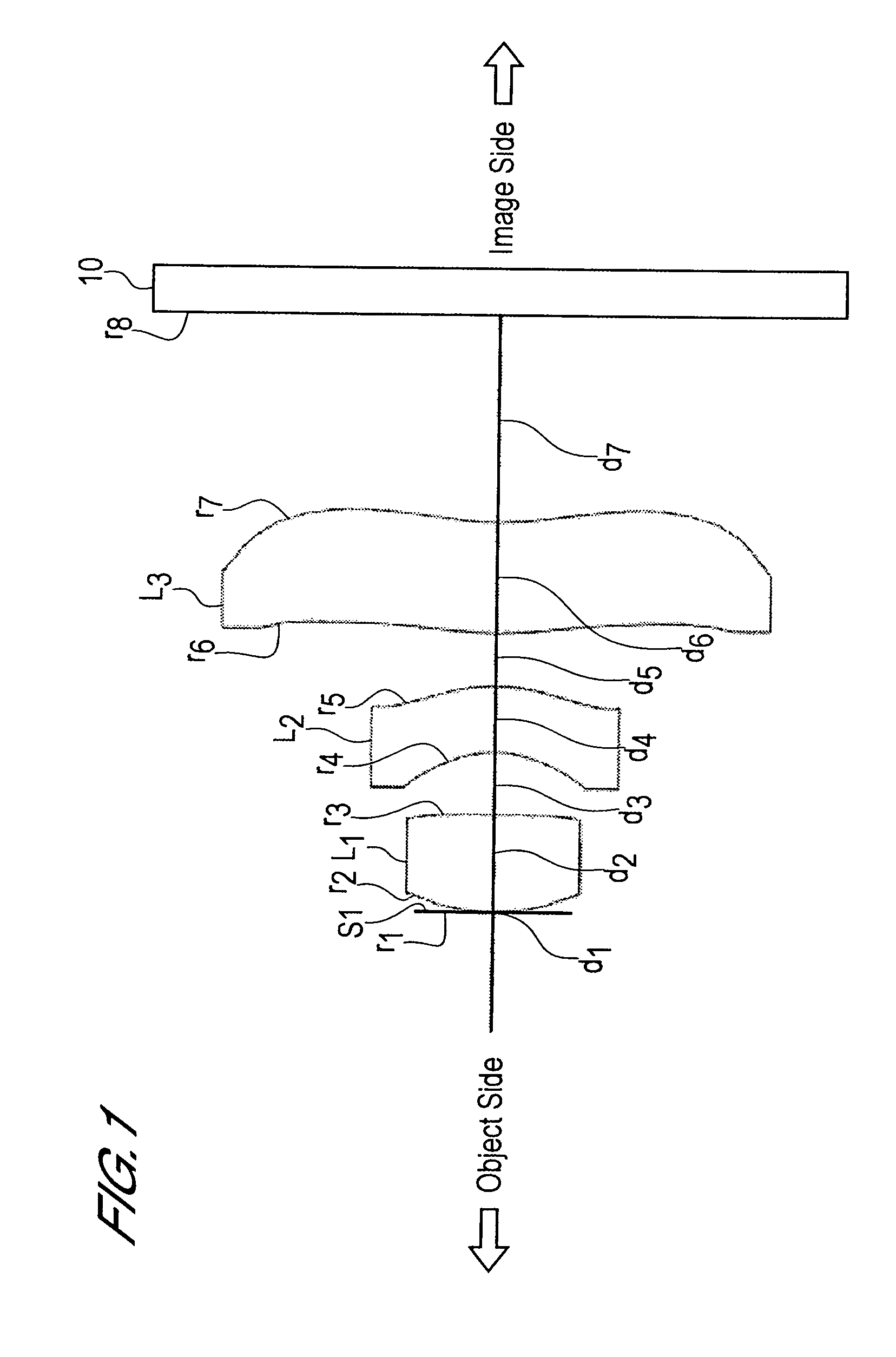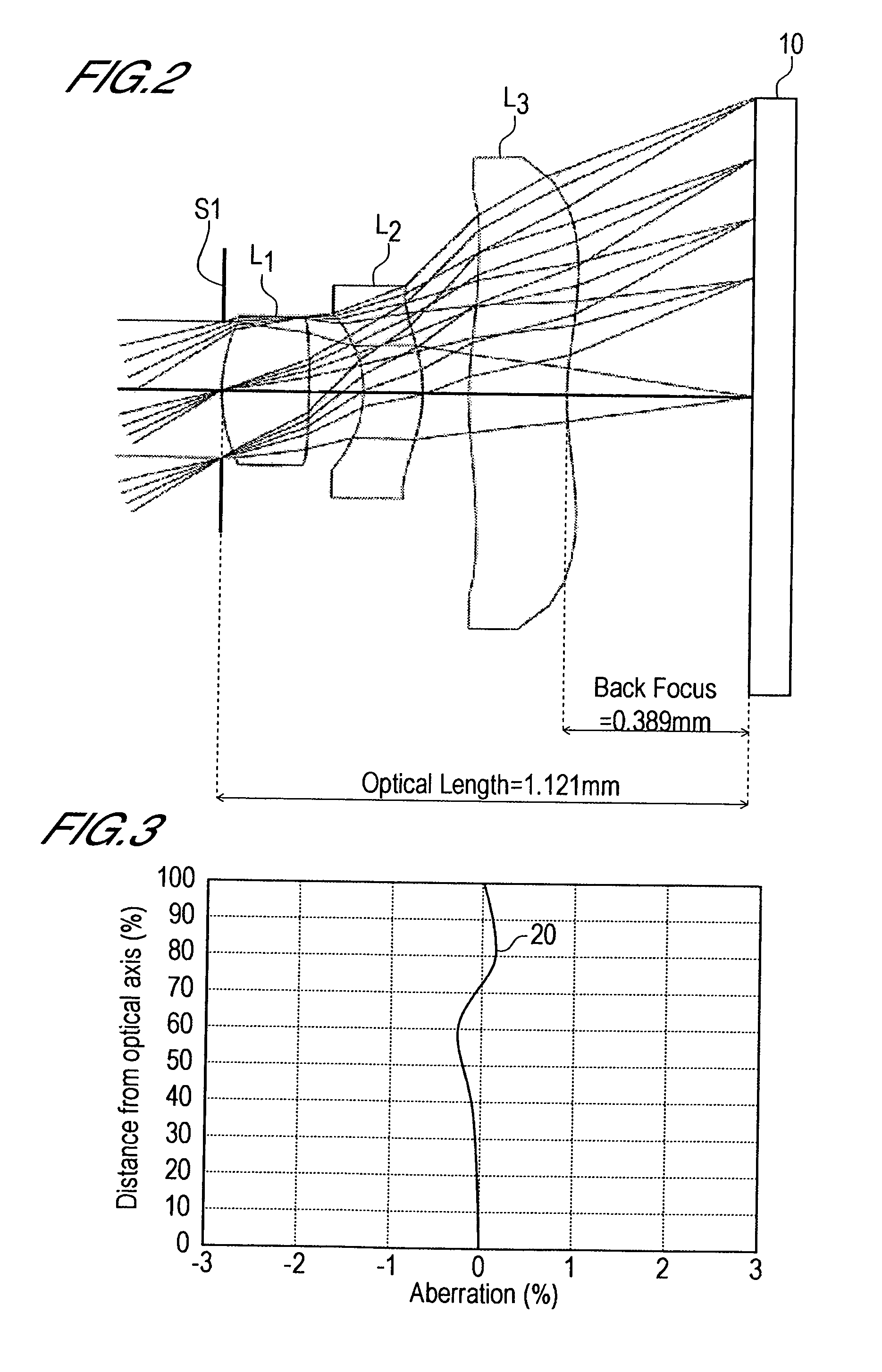Pickup lens
a technology of pick-up and lens, applied in the field of pick-up lenses, can solve the problems of inability to use the lens as a compact lens, inconvenient machine-making, and long back focus, and achieve the effects of good quality image, easy machine-making, and short optical length l
- Summary
- Abstract
- Description
- Claims
- Application Information
AI Technical Summary
Benefits of technology
Problems solved by technology
Method used
Image
Examples
first embodiment
[0171]Zeonex E48R was used as the material of the first lens L1 and third lens L3, while fluorene polyester EP-4000 (EP-4000 is a product number of Mitsubishi Gas Chemical Co., Inc.) was used as the material of the second lens L2.
[0172](A) The object-side radius of curvature r2 of the first lens L1 is r2=0.356 mm.
[0173](B) The image-side radius of curvature r3 of the first lens L1 is r3=−17.782 mm.
[0174](C) The interval D along the optical axis between the second lens L2 and the third lens L3 is D (=d5)=0.1000 mm.
[0175](D) The optical length L is L=1.121 mm.
[0176](E) The image height (length of the diagonal line in the rectangular light-receiving area) 2Y is 2Y=2×0.64=1.28 mm.
[0177](F) The focal length f1 of the first lens L1 is f1=0.66 mm.
[0178]Hence:
|r2 / r3|=10.356 / −17.782|=0.020, (1-1)
D / f=0.1000 / 1.00=0.1000, (1-2)
L / 2Y=1.121 / 1.28=0.876, and (1-3)
f1 / f=0.66 / 1.00=0.66. (1-4)
[0179]Hence the lens system of the first Embodiment satisfies each of the following condition equations (1-1...
second embodiment
[0188]ZEONEX E48R was used as the material of the first lens L1 and third lens L3, and polycarbonate was used as the material of the second lens L2.
[0189](A) The object-side radius of curvature r2 of the first lens L1 is r2=0.356 mm.
[0190](B) The image-side radius of curvature r3 of the first lens L1 is r3=−17.782 mm.
[0191](C) The interval D along the optical axis between the second lens L2 and the third lens L3 is D (=d5)=0.1000 mm.
[0192](D) The optical length L is L=1.119 mm.
[0193](E) The image height (length of the diagonal line in the rectangular light-receiving area) 2Y is 2Y=2×0.64=1.28 mm.
[0194](F) The focal length f1 of the first lens L1 is f1=0.66 mm.
[0195]Hence:
|r2 / r3|=|0.3561 / −17.782|=0.020, (1-1)
D / f=0.1000 / 1.00=0.1000, (1-2)
L / 2Y=1.119 / 1.28=0.874, and (1-3)
f1 / f=0.66 / 1.00=0.66. (1-4)
[0196]Hence the lens system of the second Embodiment satisfies each of the following condition equations (1-1) through (1-4).
0.01<|r2 / r3|<0.05 (1-1)
0.05<D / f≦0.1 (1-2)
0.6<L / 2Y<...
third embodiment
[0205]ZEONEX E48R was used as the material of the first lens L1 and third lens L3, and polycarbonate was used as the material of the second lens L2.
[0206](A) The object-side radius of curvature r2 of the first lens L1 is r2=0.356 mm.
[0207](B) The image-side radius of curvature r3 of the first lens L1 is r3=−8.887 mm.
[0208](C) The interval D along the optical axis between the second lens L2 and the third lens L3 is D (=d5)=0.08 mm.
[0209](D) The optical length L is L=1.092 mm.
[0210](E) The image height (length of the diagonal line in the rectangular light-receiving area) 2Y is 2Y=2×0.64=1.28 mm.
[0211](F) The focal length f1 of the first lens L1 is f1=0.65 mm.
[0212]Hence:
|r2 / r3|=|0.356 / −8.887|=0.04, (1-1)
D / f=0.1000 / 1.00=0.08, (1-2)
L / 2Y=1.092 / 1.28=0.8531, and (1-3)
f1 / f=0.65 / 1.00=0.65. (1-4)
[0213]Hence the lens system of the third Embodiment satisfies each of the following condition equations (1-1) through (1-4).
0.01<|r2 / r3|<0.05 (1-1)
0.05<D / f≦0.1 (1-2)
0.6<L / 2Y<0.9 (1-...
PUM
 Login to View More
Login to View More Abstract
Description
Claims
Application Information
 Login to View More
Login to View More - R&D
- Intellectual Property
- Life Sciences
- Materials
- Tech Scout
- Unparalleled Data Quality
- Higher Quality Content
- 60% Fewer Hallucinations
Browse by: Latest US Patents, China's latest patents, Technical Efficacy Thesaurus, Application Domain, Technology Topic, Popular Technical Reports.
© 2025 PatSnap. All rights reserved.Legal|Privacy policy|Modern Slavery Act Transparency Statement|Sitemap|About US| Contact US: help@patsnap.com



